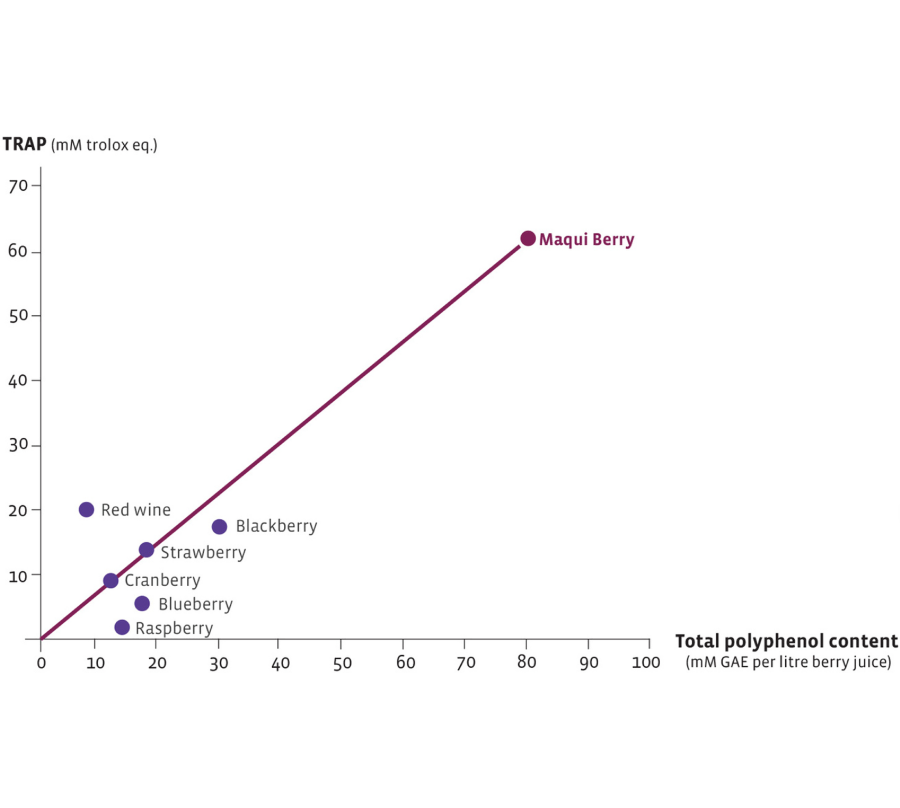Congrats on adding a Flexi section! 🎉 Go to App Embeds on the left hand side if the screen in theme settings to remove this banner. Make sure "Flexi Sections" is enabled.
Congrats on adding a Flexi section! 🎉 Go to App Embeds on the left hand side if the screen in theme settings to remove this banner. Make sure "Flexi Sections" is enabled.
The Treasure of Patagonia
Maqui berry is a native berry that grows in the wild forests of Patagonia in Chile and Argentina. This berry has been consumed from ancient times by indigenous people and is by nature extraordinarily rich in many nutrients and powerful flavonoid species known as anthocyanins. A specific category of these flavonoids, known as delphinidins, is responsible for the very dark purple color of the berries as well as for several health applications.
- 7 times more antioxidant capacity than ACAI berry and 9 times more than GOJI berry! -

Has the highest antioxidant power.
A published comparative study has revealed that Maqui berry is the richest berry in flavonoids content and correspondingly has the highest antioxidant power of all berries ever tested.

Rich in anthocyanins.
Maqui berry is one of the most anthocyanins power-packed berries from all fruits and berries for supplemental consumption, being its anthocyanins composition 25% of Cyanidins and 75% of Delphinidins. Both Anthocyanins and Delphinidins have been extensively researched, evidencing its multiples beneficial health effects.
Congrats on adding a Flexi section! 🎉 Go to App Embeds on the left hand side if the screen in theme settings to remove this banner. Make sure "Flexi Sections" is enabled.
Mechanism of Action
Delphinol® Balances Glucose Absorption

The starch obtained from food is converted into glucose with the help of the enzyme alpha-glucosidase in the intestinal lumen. Then the glucose is transported into the blood stream via a Na+-dependent glucose symport. The result is that vast quantities of glucose enter the blood stream after a meal and cause a rapid rise followed by a steep drop in blood sugar levels.
Delphinol® slows down both the breakdown of starch into glucose as well as the transport of the glucose into the blood. This causes a slowed glucose release into the blood stream and sugar levels rise steadily and more slowly. This avoids blood sugar peaks.
Congrats on adding a Flexi section! 🎉 Go to App Embeds on the left hand side if the screen in theme settings to remove this banner. Make sure "Flexi Sections" is enabled.
Delphinol® Lowers Post-Prandial Glucose

Clinical data show the impressive potential of Delphinol® in regard to a healthy glucose metabolism.
Delphinol® contributes to a healthy metabolic management.
-

Reduce Glucose
Lowers acute fasting glucose
-

Reduce HbA1c
Lasting & prominent HbA1c reduction over 3 months
-

Induces GLP-1
Induces secretion of the satiety hormone GLP-1 in vitro
Congrats on adding a Flexi section! 🎉 Go to App Embeds on the left hand side if the screen in theme settings to remove this banner. Make sure "Flexi Sections" is enabled.
Delphinol® effectively influences blood glucose already in low doses.

Source: Alvarado et al., Biomed Res Int. 2016;2016:9070537.
Congrats on adding a Flexi section! 🎉 Go to App Embeds on the left hand side if the screen in theme settings to remove this banner. Make sure "Flexi Sections" is enabled.
Regular Delphinol® intake shows lasting blood glucose lowering.
Regular Delphinol® intake lowers low-density cholesterol (LDL).
Regular Delphinol® intake rises high-density cholesterol (HDL).
Congrats on adding a Flexi section! 🎉 Go to App Embeds on the left hand side if the screen in theme settings to remove this banner. Make sure "Flexi Sections" is enabled.

Open clinical trial with 31 subjects; 180mg Delphinol® per day
Source: Alvarado et al., Panminerva Med 2016;58(Suppl. 1 to No. 3):1-6.

Open clinical trial with 31 subjects; 180mg Delphinol® per day
Source: Alvarado et al., Panminerva Med 2016;58(Suppl. 1 to No. 3):1-6.

Open clinical trial with 31 subjects; 180mg Delphinol® per day
Source: Alvarado et al., Panminerva Med 2016;58(Suppl. 1 to No. 3):1-6.
Congrats on adding a Flexi section! 🎉 Go to App Embeds on the left hand side if the screen in theme settings to remove this banner. Make sure "Flexi Sections" is enabled.

Regular Delphinol® intake shows lasting blood glucose lowering. Open clinical trial with 31 subjects; 180mg Delphinol® per day
Source: Alvarado et al., Panminerva Med 2016;58(Suppl. 1 to No. 3):1-6.

Regular Delphinol® intake lowers low-density cholesterol (LDL). Open clinical trial with 31 subjects; 180mg Delphinol® per day
Source: Alvarado et al., Panminerva Med 2016;58(Suppl. 1 to No. 3):1-6.

Regular Delphinol® intake rises high-density cholesterol (HDL). Open clinical trial with 31 subjects; 180mg Delphinol® per day
Source: Alvarado et al., Panminerva Med 2016;58(Suppl. 1 to No. 3):1-6.
Congrats on adding a Flexi section! 🎉 Go to App Embeds on the left hand side if the screen in theme settings to remove this banner. Make sure "Flexi Sections" is enabled.
Influence on GLP-1
GLP-1, or Glucagon-like Peptide-1, plays a crucial role in our glucose metabolism and is responsible for the feeling of satiety.
Delphinol® has been linked to a positive influence on the satiety hormone GLP-1. An in vitro study revealed that Delphinol® induces higher levels of the satiety hormone GLP-1.
Delphinol® not only induces GLP-1, but has also been shown to balance sugar absorption, thus flattens sugar spikes after a meal.
Congrats on adding a Flexi section! 🎉 Go to App Embeds on the left hand side if the screen in theme settings to remove this banner. Make sure "Flexi Sections" is enabled.


